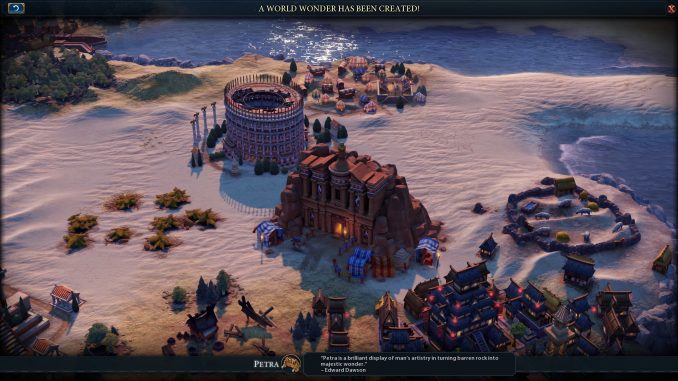
Introduction
Following this guide requires the Gathering Storm expansion.
It also assumes you have all other Civ 6 content, listed below, though it is not necessary to have these to utilise the key strategies of each civ.
- Pre-Rise and Fall content packs
- Vikings, Poland, Australia, Persia/Macedon, Nubia, Khmer/Indonesia
- Rise and Fall Expansion
- New Frontier content packs
- Maya/Grand Colombia, Ethiopia, Byzantium/Gauls, Babylon, Vietnam/Kublai Khan, Portugal
These content packs include exclusive civs, city-states, districts, buildings, wonders, natural wonders, resources, and a disaster, but not core game mechanics – all you need is the base game and the Gathering Storm expansion for those.
The sins of the Earth shall be met with divine punishment, and it falls upon us to deliver it. Let us set aside our petty internal squabbles for a greater cause. Together we shall ride forth beyond the plains, the mountains, the rivers, the seas and the ends of the earth to create our masterpiece. An empire without bounds.
How to use this guide
This guide is divided into multiple sections explaining how best to use and play against this specific civ.
- The Outline details the mechanics of how the civilization’s unique features work and what their start bias is if they have one.
- The Victory Skew section describes to what extent the civ (and its individual leaders where applicable) is inclined towards particular victory routes. This is not a rating of its power, but an indicator of the most appropriate route to victory.
- Multiple sections for Uniques explain in detail how to use each special bonus of the civilization.
- Administration describes some of the most synergistic governments, government buildings, policy cards, age bonuses, pantheons, religious beliefs, wonders, city-states and Great People for the civ. Only the ones with the most synergy with the civ’s uniques are mentioned – these are not necessarily the “best” choices when playing as the civ for a given victory route.
- Finally, the Counter-Strategies discusses how best to play against the civ, including a consideration of leader agendas if the civ is controlled by a computer.
Note that all costs (production, science, etc.) mentioned within the guide assume a game played on the normal speed settings. To modify these values for other game speeds:
- Online: Divide by 2
- Quick: Divide by 1.5
- Epic: Multiply by 1.5
- Marathon: Multiply by 3
Glossary
Terminology used in this guide and not in-game is explained here.
AoE (Area of Effect) – Bonuses or penalties that affect multiple tiles in a set radius. Positive examples include Factories (which offer production to cities within a 6 tile radius unless they’re within range of another building of the same type) and a negative example is nuclear weapons, which cause devastation over a wide radius.
Beelining – Obtaining a technology or civic quickly by only researching it and its prerequisites. Some deviation is allowed in the event that taking a technology or civic off the main track provides some kind of advantage that makes up for that (either a source of extra science/culture or access to something necessary for a eureka or inspiration boost)
CA (Civ Ability) – The unique ability of a civilization, shared by all its leaders.
Compact empires – Civs with cities close together (typically 3-4 tile gaps between city centres). This is useful if you want to make use of districts that gain adjacency bonuses from other districts, or to maximise the potential of area-of-effect bonuses later in the game.
Dispersed empires – Civs with cities that are spread out (typically 5-6 tile gaps between city centres). Civs with unique tile improvements generally favour a more dispersed empire in order to make use of them, as do civs focused on wonder construction.
GWAM – Collective name for Great Writers, Artists and Musicians. All of them can produce Great Works that offer tourism and culture, making them important to anyone seeking a cultural victory.
LA (Leader Ability) – The unique ability of a specific leader. Usually but not always, they tend to be more specific in scope than civ abilities. Some leader abilities come with an associated unique unit or infrastucture.
Prebuilding – Training a unit with the intention of upgrading it to a desired unit later. An example is building Slingers and upgrading them once Archery is unlocked.
Sniping – Targeting a specific city for capture directly, ignoring other enemy cities along the way. Typically used in the context of “capital sniping” – taking a civ’s original capital as quickly as possible to contribute towards domination victory without leading to a drawn-out war.
Start bias – The kind of terrain, terrain feature or resource a civilization is more likely to start near. This is typically used for civilizations that have early bonuses dependent on a particular terrain type. There are five tiers of start bias; civs with a tier 1 start bias are placed before civs of tier 2 and so on, increasing their odds of receiving a favourable starting location.
Complete information on start biases within the game can be found in the Civilizations.xml file (find the Civ 6 folder in Steam’s program files, then go through the Base, Assets, Gameplay and Data folders to find the file). DLC and Expansion civs have a similarly-named file in their corresponding folders.
Super-uniques – Unique units that do not replace any others. Examples include India’s Varu and Mongolia’s Keshigs.
Tall empires – Empires that emphasise city development over expansion, usually resulting in fewer, but bigger, cities.
Uniques – Collective name for civ abilities, leader abilities, unique units, unique buildings, unique districts and unique improvements.
UA (Unique Ability) – A collective name for leader abilities and civ abilities.
UB (Unique Building) – A special building which may only be constructed in the cities of a single civilization, which replaces a normal building and offers a special advantage on top.
UD (Unique District) – A special district which may only be constructed in the cities of a single civilization, which replaces a normal district, costs half as much to build and offers some unique advantages on top.
UI (Unique Improvement) – A special improvement that can only be built by the Builders of a single civilization. “UI” always refers to unique improvements in my guides and not to “user interface” or “unique infrastructure”.
UU (Unique Unit) – A special unit that may only be trained by a single civilization, and in some cases only when that civilization is led by a specific leader.
Wide empires – Empires that emphasise expansion over city development, usually resulting in more, but smaller, cities.
Outline (Part 1/2)
Start Bias
Mongolia has a tier 2 bias towards horse resources. Genghis Khan’s leader ability and the UB benefit from access to horses making this a useful bias to have
Civilization Ability:Örtöö
- Sending a trade route automatically creates a trading post in the destination city, including cities owned by you.
- With at least one trading post present in a civ, gain 1 level of diplomatic visibility. This persists even through war.
- For every level of diplomatic visibility you have with a civ higher than they have with you, gain +6 strength and religious strength instead of +3.
Genghis Khan’s Leader Ability:Mongol Horde
- All light and heavy cavalry units, as well as Keshigs, gain +3 strength.
- All light and heavy cavalry units, as well as Keshigs, have a chance to capture other light and heavy cavalry units when they are killed.
- The chance of this occurring scales based on the difference between your unit’s base melee strength (or ranged strength if it’s higher) and the base melee strength of the unit it defeats.
- If the two values are the same, the capture rate is 50%.
- For every point of strength advantage the enemy unit has, the capture rate is reduced by 2.5 percentage points. The reverse is true if the enemy unit has a lower base melee strength.
- Units with a 20-point base strength advantage or higher cannot be captured.
- Captured units will start at 25 health.
- Eligible units to be captured include unique light and heavy cavalry units, Egypt’s Maryannu Chariot Archers, Mongolia’s Keshigs and Scythia’s Saka Horse Archers.
- The chance of this occurring scales based on the difference between your unit’s base melee strength (or ranged strength if it’s higher) and the base melee strength of the unit it defeats.
Kublai Khan’s Leader Ability:Gerege
- All governments receive an extra economic policy card slot.
- When first establishing a trading post in another full civ, gain a random eureka and inspiration boost.
- You may only receive this bonus once per full civ you send a route to.
- The random eureka and inspirations will favour technologies and civics you are able to research but lack the boosts for.
Outline (Part 2/2)
Unique Unit:Keshig
A medieval-era ranged land unit which does not replace anything
| Research | Obsoletion | Upgrades from | Upgrades to | Cost | Resource | Maintenance |

Stirrups |

Ballistics |
None | 
Field Cannon |
160 or or |
10 |
3 |
*Purchasing units with faith requires the Grand Master’s Chapel government building, which requires either the medieval-era Divine Right or renaissance-era Exploration civics.
| Strength | Ranged Strength | Moves | Range | Sight | Negative Attributes | Positive Attributes |
| 35 |
45 |
4 |
2 |
2 |
|
|
Notable features
Compared to Crossbowmen, Keshigs have the following negative changes:
- Unlocked at the late-medieval Stirrups technology instead of the early-medieval Machinery technology.
- Cannot be upgraded into
- Require 10 horses to train
- Costs 350 gold, up from 310, to upgrade to a Field Cannon (+13%)
- Has a vulnerability to anti-cavalry units and bonuses
And the following positive changes:
- Costs 160 production/640 gold/320 faith, down from 180/720/360 (-11%)
- Has 35 strength, up from 30
- Has 45 ranged strength, up from 40
- Has 4 movement points, up from 4.
- Ignores zone of control
- Allows formation units to inherit its movement speed
- Units affected include attached civilian units (such as Great Generals) and support units (such as Siege Towers) but not religious units.
- To use this ability, move the Keshig, not the unit it’s in formation with.
- This works even if the formation unit has no remaining movement points.
- This works even if the units are embarked.
Unique Building:Ordu
A classical-era Encampment building which replaces the Stable
| Research | Prerequisites | Required to build | Cost | Maintenance | Base pillage yield |

Horseback Riding |

Encampment Must not already |

Armoury Military Academy |
105 or or |
1 |
None |
*Purchasing Encampment buildings with faith requires you to be suzerain over the Valletta city-state.
| Fixed yields | Other yields | Citizen slots | Great Person points | Miscellaneous effects |
| 1 1 |
None | 1 Commander (1 and 1 ) |
1 |
|
Positive changes
- Light cavalry, heavy cavalry and Keshig units trained in this city gain +1 movement point.
- The movement bonus even applies when the units are embarked.
- This is kept when the unit is upgraded.
Victory Skew
In this section, the civ is subjectively graded based on how much it leans towards a specific victory type – not how powerful it is. Scores of 3 or more mean the civ has at least a minor advantage towards the victory route.
| Leader | 
Culture |

Diplomacy |

Domination |

Religion |

Science |
| Genghis Khan | 4/10 (Acceptable) |
3/10 (Acceptable) |
10/10 (Ideal) |
5/10 (Decent) |
3/10 (Acceptable) |
| Kublai Khan | 6/10 (Decent) |
5/10 (Decent) |
9/10 (Ideal) |
6/10 (Decent) |
6/10 (Decent) |
Between the two leaders, Genghis Khan is very focused on the domination game, while Kublai Khan is far more versatile.
For the cultural game, Mongolia has some small bonuses that may help (in addition to simply capturing high-tourism spots from other civs). A boost to diplomatic visibility helps you get to level 2 (Open) status, which tells you when civs are starting construction of wonders – letting you know which wonders you can risk building and which you can’t. Instant trading posts help you trade with more distant civs sooner for the 25% tourism boost. Finally, Keshigs can escort units like Naturalists and Archaeologists over vast distances rapidly. On top of this, Kublai Khan gets bonus inspirations and an extra economic policy card slot; the latter is great for squeezing in more wonder-construction or tourism bonuses.
Domination is the obvious route. Mongolia requires a bit of set-up for maximum effectiveness, but they can take down other civs at alarmingly fast speeds once they get going. Mongolia does have the disadvantages of being heavily reliant on cavalry units and needing to track down specific strategic resources, but the combined mobility and speed advantages are huge. Genghis Khan has even more strength for cavalry on top, while Kublai Khan offers more in the way of economic support.
Religious victory is surprisingly effective – so long as you can found a religion in the first place. Mongolia’s civ ability boosts the strength of religious units in theological combat, and getting to a high level of diplomatic visibility is much easier in peace than war. Kublai Khan can use his extra economic policy card slot to squeeze in more faith bonuses.
Mongolia under Genghis Khan isn’t really suited to scientific victories, unless you’ve captured a lot of high-science or high-production cities. For Kublai Khan, however, a small number of free eurekas and the economic policy card slot can help your science output to take off.
Civilization Ability:Örtöö(Part 1/2)
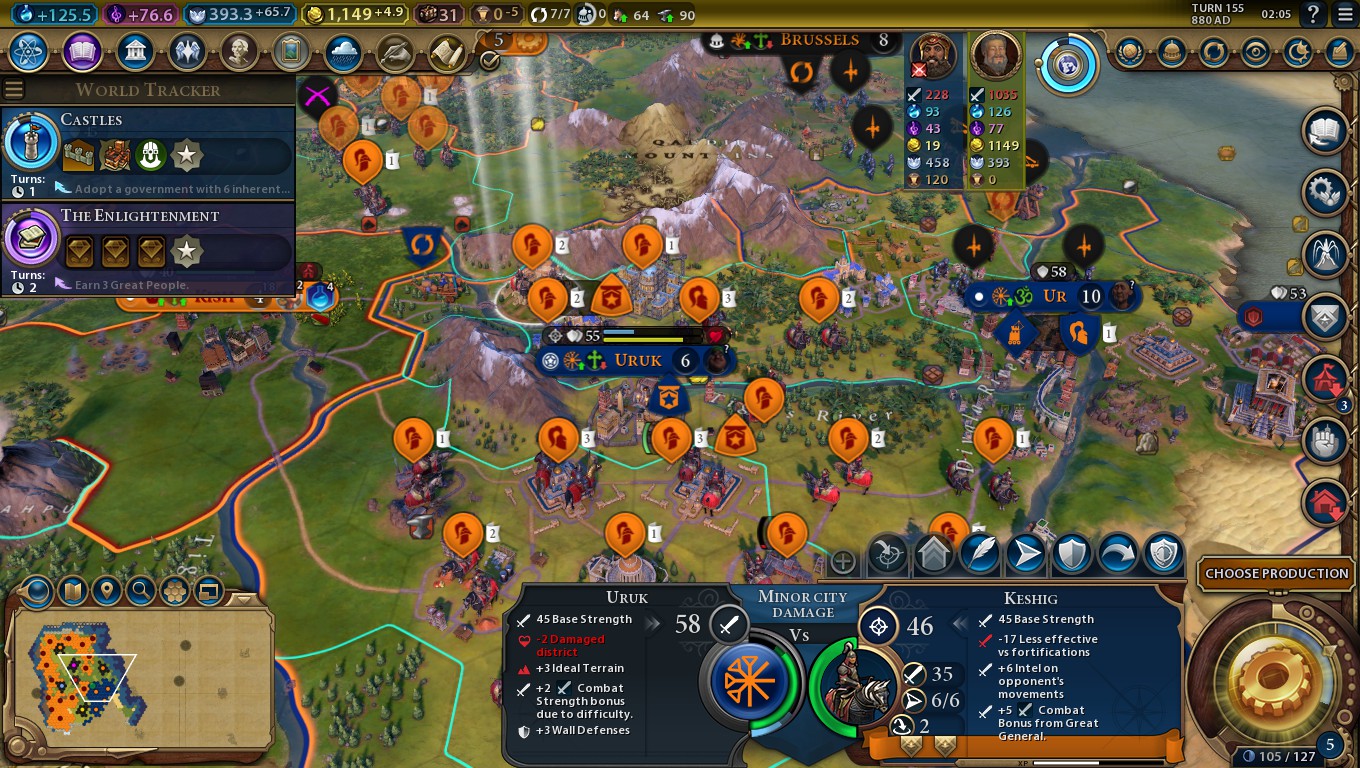
See that +6 strength for “intel on other opponent’s movements”? That’s the ability in action!
Much like France under Black Queen Catherine de’ Medici, Mongolia has an advantage to learning more about their opponents. Unlike France, Mongolia emphasises the direct strength benefits of diplomatic visibility, rather than its espionage role.
Making use of this ability is easy. All you need to do is send a trade route to a city owned by another civ, preferably one that you don’t intend to capture early in a potential war. Early on, if there’s more than one possible civ to send the route to, it’s a good idea to send the trade route to whichever civ is more likely to declare war on you so you have the strength bonus ready just in case.
It’s a good idea where possible to send a trade route to another civ’s capital. Aside from generally giving you better yields, it also ensures you keep a trading post in their civ (and hence the diplomatic visibility bonus) until you take the one city you need from them for domination victory.
Diplomatic Visibility Mechanics
Diplomatic visibility lets you find out more about what’s going on in a civ, and helps you fight them more effectively.
Firstly, here’s what’s revealed at each level of diplomatic visibility:
| Level | Name | Revealed | Notes |
| 0 |
None |
|
Everyone who has met this civ will know about this. |
| 1 |
Limited |
|
This gives you a clue to the civ’s relationship with other civs. Learning about founded cities gives you an insight into how powerful the civ is even if you can’t see all their territory. |
| 2 |
Open |
|
Here’s where things start getting really useful. In singleplayer, revealing secret agendas makes it easier to play the diplomacy game and work out what other civs want. Knowing what wonders other civs are chasing lets you work out when’s a good time to stop putting one off, or to switch attention to another wonder. |
| 3 |
Secret |
|
This gives you much clearer information on where a civ is on the technology or civics tree than the vague technology/civic timeline, giving you a good indication of their real power – and how vulnerable they might be to Garde Impériale units. It also tells you about some of the nastier Spy actions the civ may have undertaken. |
| 4 |
Top Secret |
|
Lets you know a great deal of the specifics of what’s happening in someone’s lands. If they’re building spaceship parts, be prepared to send some Spies over to disrupt it. |
*Does not work against human players.
If you have a higher level of diplomatic visibility with a civ than vice versa, you’ll gain a +3 strength bonus per level. For Mongolia, this is doubled to +6. The following table shows what that can mean:
| Mongolia’s Diplomatic Visibility Advantage |
Mongolia’s Strength Advantage |
| -4 |
-12 |
| -3 |
-9 |
| -2 |
-6 |
| -1 |
-3 |
| 0 |
0 |
| 1 |
6 |
| 2 |
12 |
| 3 |
18 |
| 4 |
24 |
Civilization Ability:Örtöö(Part 2/2)
Using the Strength Bonus
Because Mongolia’s strength bonus gets stronger the higher diplomatic visibility you can get, you’ll want to find a range of bonuses to it that work in war-time. These include:
- Mongolia’s bonus for having a trading post present in the target civ.
- Researching the renaissance-era Printing technology.
- Sending a Spy on a Listening Post mission to the target civ (requires the renaissance-era Diplomatic Service civic). Unlike other Spy missions, this provides you the benefit immediately. Consider sending the Spy to a low-priority city you don’t intend to capture early in the war, or the civ’s capital, but not the same city you have a trading post present in, just in case a third civ captures it.
- Using the modern-era Great Merchant Mary Katherine Goddard.
If your target civ has any of those advantages against you, then your strength bonus will be weakened.
The trick to making the most of this bonus is to push for the Printing technology once you’re done with Stirrups, and getting to Diplomatic Service fairly soon so you can set up your first Spy. Don’t delay your Knight/Keshig wars in order to get these bonuses first – you can work towards them while your wars are still ongoing.
Both Printing and Diplomatic Service aren’t commonly high-priority research targets for civs, so you should be able to get a considerable bonus through the early parts of the renaissance era. Nonetheless, into the late parts of the renaissance era, prepare to see wars become considerably harder as your civ ability’s strength bonus is slashed and Pike and Shot units arrive to cause trouble for your Knights and Keshigs.
Advanced Trading Post Usage
Mongolia’s instant trading posts are largely used to quickly establish a diplomatic visibility bonus against civs, but they don’t have to be used that way. Your own established trading posts in cities also grant you +1 gold when your trade routes pass through them, and reset the range of the routes, allowing them to travel much further.
To make the most of this bonus, you’ll want to have at least a couple of Traders available. Send the first to a distant city, and then you can immediately use the second to trade to a more distant city via the first one. Other civs would have to wait quite some time to be able to trade that far!
Aside from the slight bit of extra gold, this also helps you establish diplomatic visibility in civs that are further away. Considering the world will probably turn on you after your first war, getting trading posts up in as many civs as possible as soon as possible is a good idea. Still, even if other civs pillage your routes, you’ll still enjoy having those trading posts immediately active.
As an alternative, you can trade within your civ, sending trade routes to different cities each time. Soon enough you will be able to amass a decent gold bonus.
Finally note that setting up a trading post in every other full civ grants you 3 era score, or 5 if you’re the first civ in the world to do so. Mongolia should usually be able to achieve this.
Summary
- Send traders to cities of full civs that you’re unlikely to capture early in a potential war, or the capital (as it’s likely to be the hardest target).
- Once you have the Stirrups technology, research the Printing technology and Diplomatic Service civic as soon as you can for extra diplomatic visibility.
Kublai Khan’s Leader Ability:Gerege
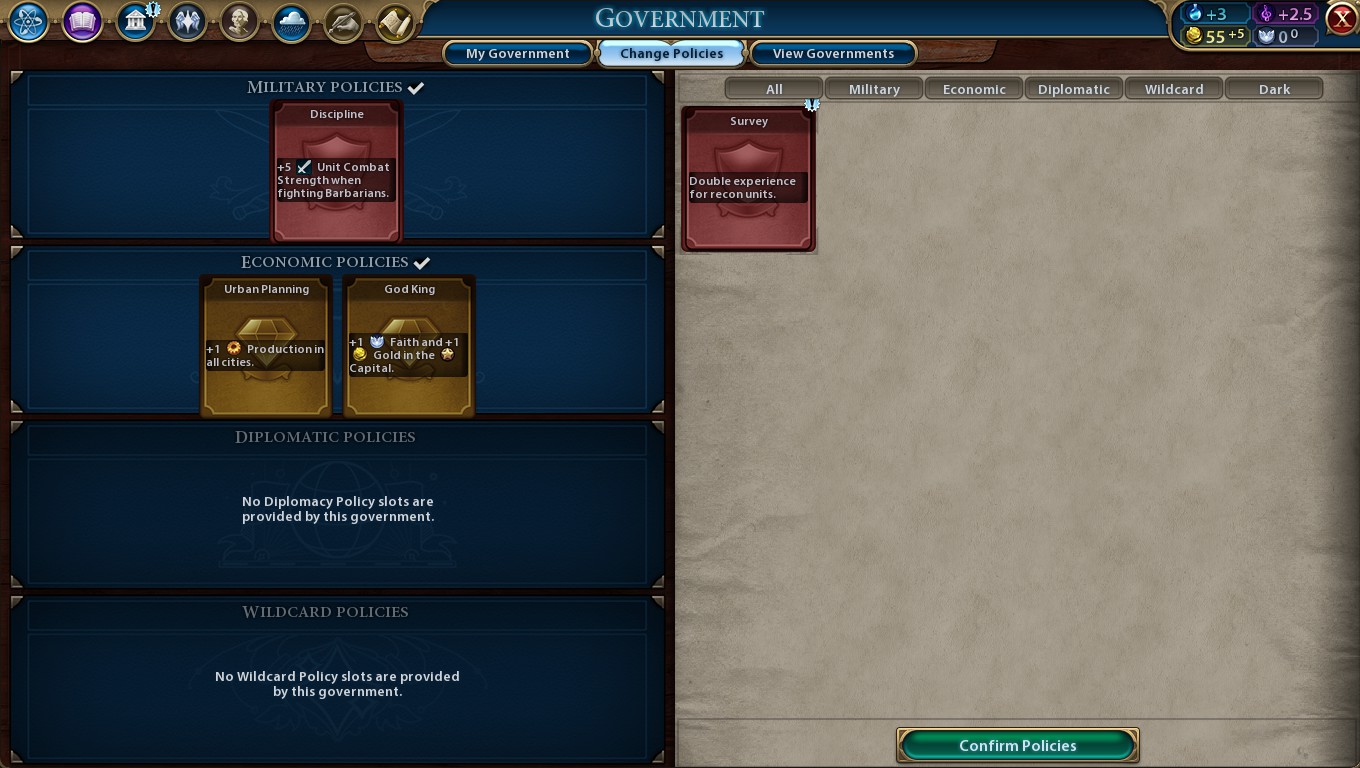
Mongolia’s two leaders both work best engaging in cavalry-heavy warfare. However, while Genghis Khan doubles down on direct warfare advantages, Kublai Khan offers economic support.
As a general rule, Kublai Khan can launch a Keshig war slightly sooner and has better backup victory routes, but Genghis Khan is even better at domination overall and is less at risk if he falls behind in technology.
+1 economic policy card slot
Starting with a second economic policy card slot allows you to stack Urban Planning and Ilkum or Colonisation together to gain two lots of production bonuses towards key early civilian units.
The Urban Planning/Ilkum combination in particular helps you train plenty of Builders. You’ll need a pasture for the eureka for Horseback Riding, three mines for the eureka for Apprenticeship and six farms for the inspiration for Feudalism, both of which are crucial bits of research for Mongolia. Horseback Riding unlocks the Ordu UB, Apprenticeship is on the way to Stirrups (needed for Keshigs) and Feudalism is required for the Feudal Contract military policy card, which allows you to train Keshigs faster.
Further into the game, more economic policy card slots makes it easier to stack cards which offer gold and amenity bonuses, both of which are important to supporting warfare. Keshig maintenance can really add up once you train enough of them, and conquest will spread your amenities thin.
Ultimately, the economic policy card is a reliably useful bonus for Mongolia which doesn’t require particularly careful planning. For more ideas on what to put in the extra policy card slot, look at the Administration section of this guide.
Boosts from trading posts
Setting up trading posts in another civ for the first time as Kublai Khan awards you with a random eureka and inspiration. Because you will only receive this reward once per civ, the total number of boosts on offer is fairly limited, and will generally depend on your map size. Duel-sized maps have just two civs by default, so you’ll only be able to get one eureka and one inspiration. On Huge maps, which have 12 civs by default, you can get 11 of each!
Despite being the same bonus, Kublai Khan leading Mongolia should use this abiltiy differently to Kublai Khan leading China for two key reasons: One, Mongolia makes trading posts immediately when setting up a trade route rather than at the route’s completion, and two, getting to Keshigs quickly is a key part of the Mongolian game. As such, Kublai Khan leading Mongolia should aim to send trade routes to lots of different civs early in the game. The more early boosts you can get, the faster you can get to the Stirrups technology and Feudalism civic, the sooner you can launch Keshig wars and the more successful they’ll be.
To maximise the number of boosts you can get early on, consider deliberately luring Barbarians over to pillage your trade route, allowing you to free up the trade route capacity and set up a new trade route to a different civ. You can alternatively directly declare war on a city-state your trade route passes near.
Conclusion
Kublai Khan has an easy-to-use leader ability which offers a consistent economic support for Mongolia’s typical games of conquest. It also suits backup strategies better than Genghis Khan’s relentless domnation focus, though at the cost of some strength in warfare.
Unique Building:Ordu
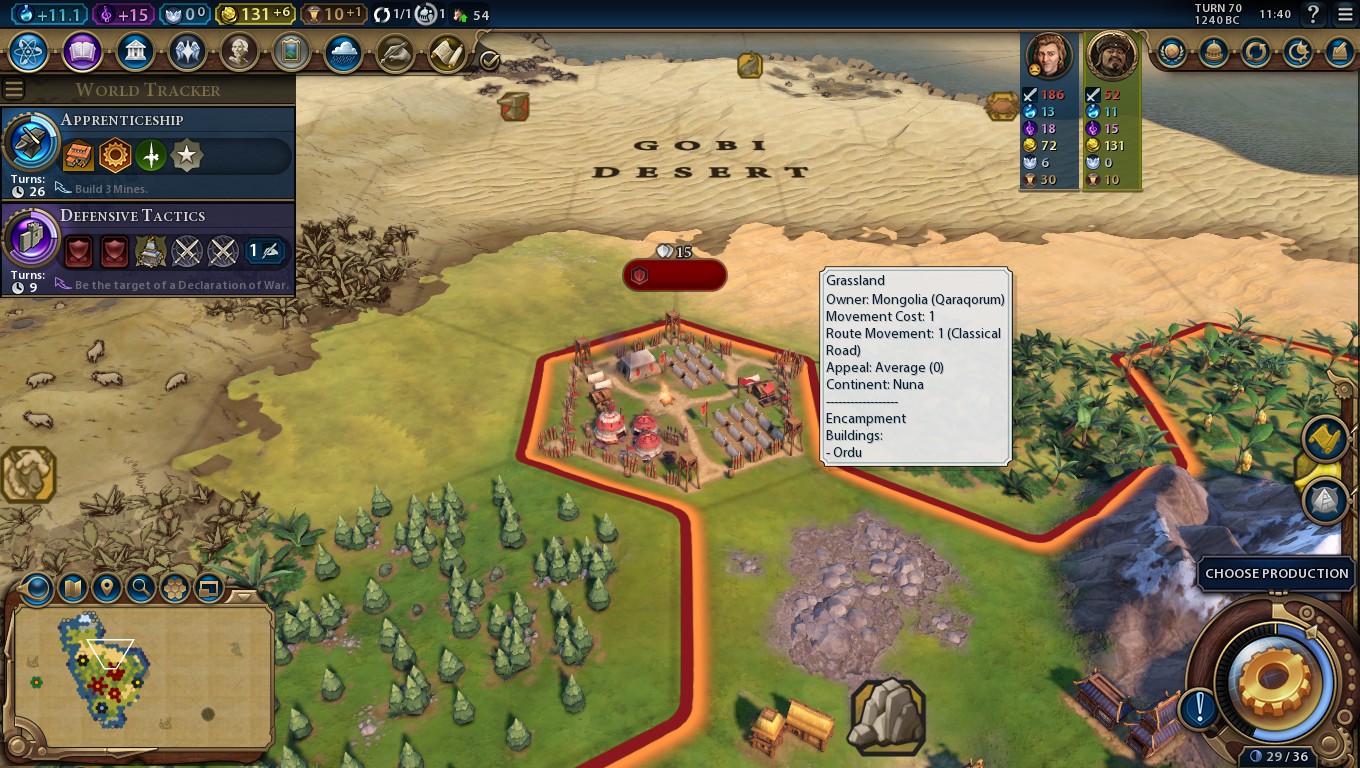
Though the Ordu’s effect seems minor at first glance, it grants Mongolia a near-unrivalled speed advantage on land allowing you to take down other civs at an alarmingly fast rate.
Preparation
The Ordu UB requires Horseback Riding, though the Encampment district requires Bronze Working. It’s a good idea to research Animal Husbandry first to reveal horses (which you’ll need for Keshigs, then Mining and Bronze Working, and finally work towards Horseback Riding.
Getting early Encampments will help you on your way to your first Great General, but don’t neglect expansion as well – at a minimum you should have three cities reasonably early so they can share the load of unit production. Researching Bronze Working also reveals iron, which is needed to train Knights or upgrade heavy Chariots to them – be sure to settle one of your cities near an iron spot, or else you’ll have to fight your wars using inferior Horsemen or take a technological detour for Coursers.
It also helps to have some Monuments so you can get to key civics like Political Philosophy, Feudalism and Mercenaries sooner, and a good Campus or two to cut down the time needed to reach the key Stirrups technology, which unlocks both Knights and Keshigs. That being said, you can somewhat mitigate this with Governor Pingala (the Educator) and his science/culture-granting promotions. You’ll want Commercial Hubs and Markets as well to cover maintenance costs, but that can wait until you’ve launched your first war.
Once Ordu are established…
Once you have Horseback Riding and have established your UB in some cities, consider researching the Wheel and train up some Heavy Chariots in those cities. The Manoeuvre and Conscription military policy cards together will help you produce them at a rapid rate while also avoiding maintenance costs, meaning you’ll have a decent-sized force ready for upgrading to Knights and a decent treasury prepared to let you do that.
Alternatively, you may want to focus on Commerical Hubs, Markets and Builders to develop your gold and production infrastructure ready for training Keshigs. You’ll generally want a lot more Keshigs than Knights, but either approach works.
While you work towards the Stirrups technology, also head towards the Feudalism civic. Feudalism unlocks the eureka boost for Stirrups and the Feudal Contract military policy card, required to train Keshigs faster. With the Stirrups technology, you can then train Keshigs while working your way to the Mercenaries civic. Mercenaries unlocks the Professional Army military policy card, which halves the cost of upgrading units.
With your Heavy Chariots upgraded to Knights and your Keshigs trained, you’ll be ready to go to war.
Making Use of Extra Movement
With the speed bonus Ordu offer to Knights and Keshigs, in addition to a classical or medieval-era Great General, your army will move at a speed of six tiles per turn. This typically means you can move from one city to the next in a single turn during a war, meaning you can cut the time needed to take the next city. You’ll usually be able to conquer fast enough that loyalty won’t be an issue.
Bumping units up to six movement points can also help you manage maintenance costs, research and injured units, as they’ll have more movement points free to pillage. Pillaging costs 3 movement points, but for fully-boosted Keshigs and Knights they’ll still have three points left over to move and fight. Pillage farms for unit health, trade routes or pastures for gold, mines or lumber mills for science, quarries for culture and so forth – you’ll be able to easily fix those improvements later with captured Builders.
The extra movement also applies to embarked units. If you exhaust conquest targets in your home continent, getting the Cartography technology will allow your units to cross oceans. With a Great General, your Ordu-boosted units will move at 4 movement points when embarked, 5 with Square Rigging, 7 with Steam Power or 8 with both Steam Power and Combustion.
Finally, boosted movement makes the ability of Keshigs to escort formation units even more effective – more about that will be covered in the unit’s section.
Summary
- Research Horseback Riding first to find horses
- Research Bronze Working early to find iron spots and build Encampments
- Make a detour to the Wheel technology once you have Ordu built so you can train Heavy Chariots to upgrade later.
- Extra movement helps save time in warfare and makes pillaging more viable.
Unique Unit:Keshig
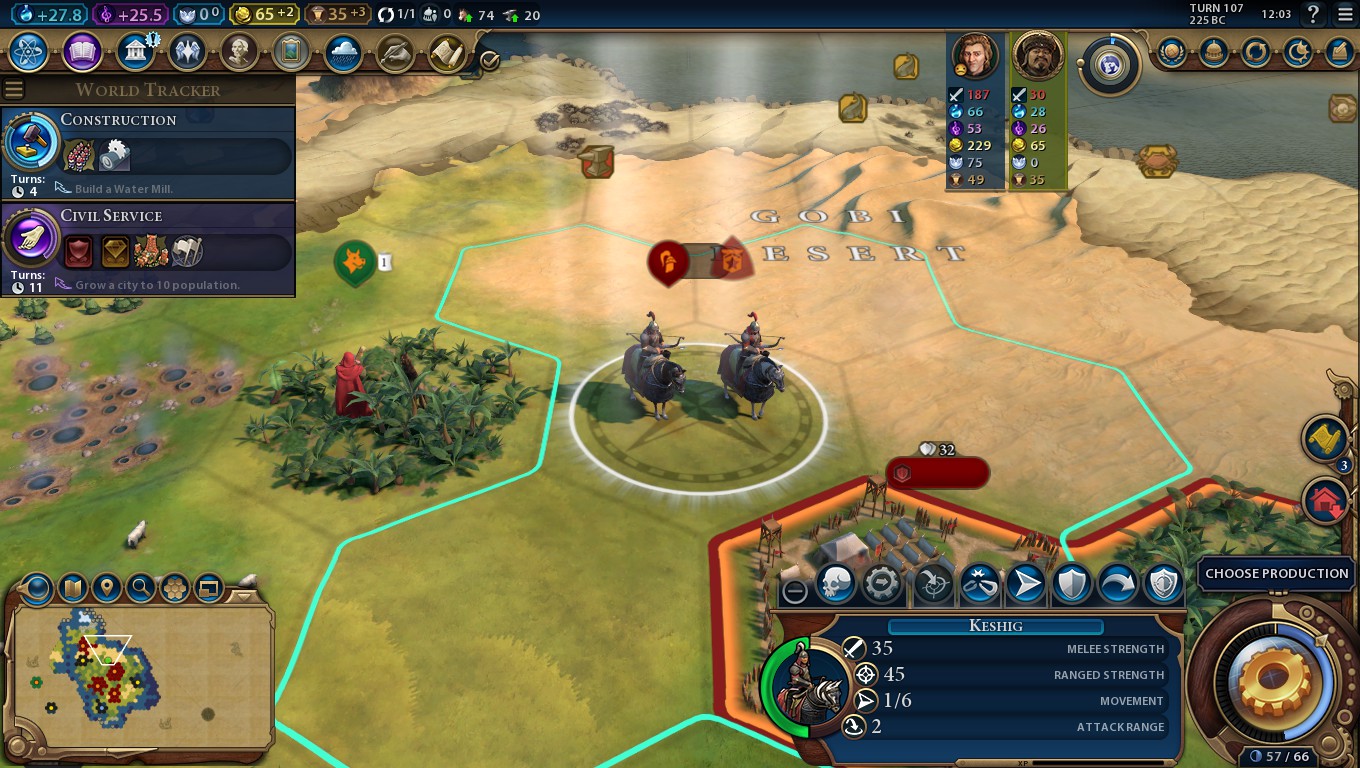
With your Knights, Keshigs, and a classical or medieval-era Great General, it’s time to get your wars started! You’ll be able to rapidly sweep across the map, taking cities so fast loyalty won’t have time to register as a problem.
Standard Usage
Keshigs can be thought of as an extra-mobile Crossbowman, though with even more strength (boosted further with the civ ability and Genghis Khan’s leader ability. Having a ranged attack and high mobility makes them great at avoiding danger, and even if they get injured, you can simply pillage farms for health and still have movement points left over.
Keshigs also ignore zone of control, like Knights do. This allows you to slip around enemy defences and surround them more easily, or escape from enemy units.
On the other hand, Keshigs also have a vulnerability to anti-cavalry units. Pikeman are a particular danger, as they essentially have 55 strength when fighting your Keshigs – as much as a Musketman! Even with one +6 strength bonus from having one higher level of diplomatic visibility than vice versa – even with Genghis Khan’s leader ability on top – that still puts Keshigs at a disadvantage. Thankfully, with enough Keshigs you’ll be able to bombard them enough to take them out before they can react. Keshigs are cheaper to train than Pikemen so in the long run things may balance out.
Though Keshigs have a -17 strength penalty against cities, they only have a 50% damage penalty against city walls relative to the -85% penalty Knights have. This means with enough Keshigs, you can forgo the need for siege units. Furthermore, you can escort Great Generals or Siege Towers/Battering Rams to the front lines with ease to help with sieges – though you’ll need melee infantry or anti-cavalry units to use the latter of these.
If your Great General-escorting Keshig is next to an enemy city, be sure to delay attacking with them at the start of each turn. That means if you capture that city, you can then move the units on to the next city without needing to spend another turn doing so.
Beyond the Medieval Era
Keshigs will stay relevant through the renaissance era thanks to the Printing technology and the opportunity for Mongolia’s first spy at Diplomatic Service, helping to bump up your diplomatic visibility and therefore your units’ strength. Getting to the renaissance-era Nationalism civic will also help, as Keshig corps have a strength and ranged strength only five points short of a Field Cannon, but for a cheaper cost and considerably better mobility.
Watch out for enemy Pike and Shot units. They’ll fight at a massive 65 strength against your Keshigs, which is enough to kill them in a single hit if they are not formed into a corps. Once Pike and Shot corps are formed, corps/armies for industrial-era units or any modern-era unit appears, it’s a good idea to start upgrading your Keshigs – or else use them purely for their ability to speed up units in formation.
The Ballistics technology allows you to upgrade both Knights and Keshigs to Curiassiers and Field Cannons respectively. Curiassiers are quite powerful, but Field Cannons are considerably less mobile than Keshigs and lack the ability to ignore zone of control. As such, you may want to start moving to Artillery or Bombers as a main means to siege down enemy cities.
Advanced Usage
The ability of Keshigs to escort civilian and support units at great speeds isn’t just limited to getting Great Generals and Battering Rams or Siege Towers moving at the same speed as the rest of your army…
Starting with a Keshig and a unit in formation, you can move it a few tiles, detach once the Keshig has one movement point remaining, move out the Keshig, move in a new one, reattach and continue. This even works when the units are embarked! This allows you to move civilian or support units across entire continents in a single turn if you have enough Keshigs.
This trick gives Keshigs a useful peace-time role: escorting civilian units to quickly reach new destinations. A chain of Keshigs can get a new Settler to a good city spot quickly, an Archaeologist to an antiquity site, or a Builder to a remote weak city that lacks the production to train their own.
Furthermore, this function can be used late in the game to get new support units closer to the front lines of a war. Don’t get too close to the front lines, however – even with Mongolia’s civ ability and Genghis Khan’s leader ability Keshigs won’t last long against units that arrive later in the game.
Summary
- Keshigs are great at dealing with enemy units and city defences alike – bring Knights to finish off the cities.
- Watch out for Pikemen or Pike and Shot units.
- A chain of Keshigs allows civilian or support units to cross vast distances in one turn, even over water.
Genghis Khan’s Leader Ability:Mongol Horde(Part 1/2)
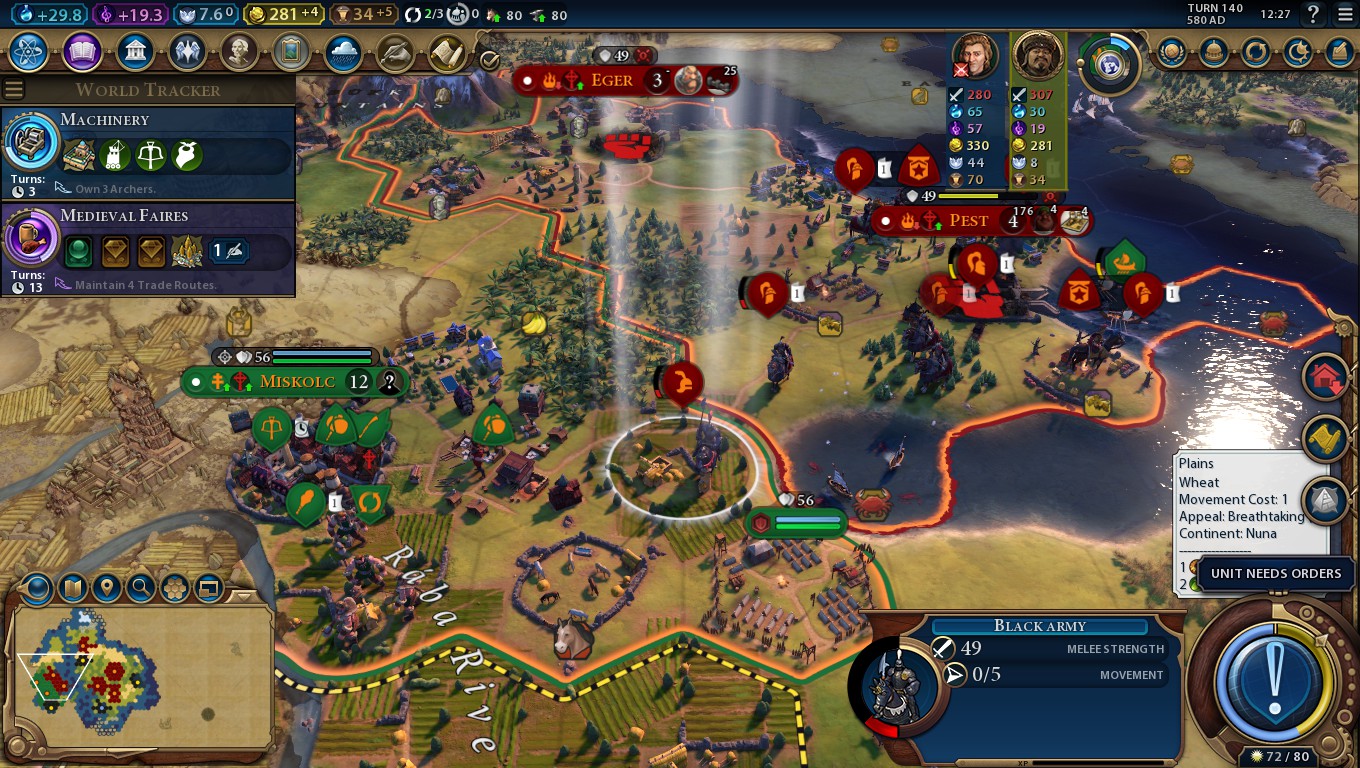
You can even capture unique units, including Scythia’s Saka Horse Archers!
Genghis Khan brings two bonuses to the table:
- A +3 strength bonus to all your cavalry units (including Keshigs) in all situations – a bonus so straightforward it doesn’t really need elaboration, and…
- The opportunity to convert defeated enemy cavalry units.
Converting defeated enemy cavalry is the more interesting bonus, even if it doesn’t come into play as often.
When hovering your mouse over an eligible target with a cavalry unit/Keshig selected, it’ll tell you the odds of capturing the cavalry unit. The lower the unit’s base melee strength relative to your own unit’s melee strength (or ranged strength if it’s higher), the more likely you are to capture it. While you’re using Keshigs and Knights, you should generally use Knights to finish off enemy cavalry units as they’ll have a better chance of capturing them.
Captured cavalry units start at only 25 health, so they’re prone to being killed immediately if you can’t clear the area of enemy units. Losing a unit in enemy territory, even if it’s one that originally belonged to another civ, will cause you to suffer a war weariness penalty, so you should probably aim to kill as many other nearby units as possible before you convert cavalry to your side.
Another subtle downside of this ability is that it’ll eventually steer other civs into not using cavalry against you, probably leading to you facing more anti-cavalry units. On the other hand, if they’re not using as many fast units against you, it’ll be easy for your own cavalry to withdraw if they get injured without being intercepted.
Stealing Unique Units
Perhaps the best thing about Genghis Khan’s leader ability is the way it lets you capture unique units from other civs. Be aware that they’ll typically be slower than your own cavalry as they can’t benefit from the Ordu movement bonus, and you can’t form corps or armies with them without capturing more.
Here’s all the unique units you can capture in rough chronological order. For full details on each unit, go to the “Other Guides” section at the end of the guide and click a link to the corresponding civ.
Note that Vietnam’s Voi Chiến unit, while looking like a ranged cavalry unit, does not count as one and therefore Mongolia cannot capture it.
Sumeria – War-Cart
War-Carts are slightly stronger than Heavy Chariots, but the +3 strength bonus Genghis Khan’s leader ability offers will help you capture them. War-Carts have the notable advantage of being immune to anti-cavalry bonuses, making them excellent at clearing out Barbarian encampments, which are often guarded by Spearmen. There is one downside, however – upgrading them to Knights is slightly more expensive.
Egypt – Maryannu Chariot Archer
Maryannu Chariot Archers have a ranged strength of 35, which is huge for the ancient era. With a melee strength of 25, even Heavy Chariots can capture them at a reasonable rate, but be sure your units don’t die trying. The units can make effective Barbarian-killers thanks to their mobility and ranged attack.
Macedon – Hetairoi
This Horseman replacement counts as a heavy cavalry unit, and therefore can be upgraded to a Knight. It can be upgraded to a Knight for a lower cost than Heavy Chariots, so it’s worth keeping any you capture around.
Despite the strength bonus the unit receives from sharing a tile with a Great General, it’s not any harder to capture than a generic Horseman as its base strength is the same. Still, be sure to bring plenty of units when taking on Macedon so you can actually kill this in the first place.
Scythia – Saka Horse Archer
Scythia’s ability to spam light cavalry and Saka Horse Archers makes them a lovely opponent for Mongolia. This UU in particular has low defence, so can usually be converted. Just beware of it being killed immediately after you capture it!
Saka Horse Archers aren’t particularly strong in Mongolia’s hands, meaning you’ll probably want to use them for pillaging or risky moves where you don’t mind losing them.
India – Varu
This special classical-era heavy cavalry unit is slow but strong. It won’t be able to keep up with your Knights or Keshigs, but it’s not bad as a defensive unit to guard your core cities while the rest of your army is away.
Because Varu make adjacent units weaker, it helps to use ranged attacks from Keshigs to capture them.
Genghis Khan’s Leader Ability:Mongol Horde(Part 2/2)
Arabia – Mamluk
Knights are already great for Mongolia, but now you can grab yourself a Knight that heals up every turn! So long as you can hit them hard with a lot of attacks in a single turn, they’re no harder to capture than Knights, and their heal-per-turn ability in your hands complements the fast pace of Mongolian warfare nicely.
The medieval-era Great Scientist Abu Al-Qasim Al-Zahrawi makes adjacent units heal 20 HP per turn faster, which goes nicely with the ability of Mamluks to heal every turn. Furthermore, you can get them in formation with a Keshig to ensure they can keep up with your Mamluks and constantly offer the extra health boost.
Byzantium – Tagma
An absolutely amazing unit for Mongolia to capture, as you’ll be able to use its unique bonus even more effectively as Byzantium can! It makes adjacent units gain +4 strength, allowing you to surround it with Keshigs and deal considerably more damage per turn. Furthermore, as Tagmata don’t have any higher base strength than regular Knights, the chance of capturing them is reasonably good.
Mali – Mandekalu Cavalry
Another great unit for Mongolia to pick up. It has an impressive 55 strength, making it harder to capture but rewarding if you do. You can use its higher strength to put it to work capturing enemy cavalry units at a better rate, and killing enemy units will also generate you gold equal to its strength.
Furthermore, if Mandekalu Cavalry are not embarked, they prevent Traders within four tiles from being pillaged. This can be useful when dealing with Barbarian Outposts too close to your trade routes.
Ethiopia – Oromo Cavalry
Oromo Cavalry is highly mobile in hills, and has a boosted sight radius. Being mobile in hills makes it excellent as a flanking unit in places where flanking enemy units and cities may be difficult, and the extra sight helps you see threats like Pikemen coming before they can reach your units. Their strength is slightly higher than a generic Courser, but still lower than a Knight so they shouldn’t be too hard to capture.
Hungary – Black Army
Hungary has two unique light cavalry units, and while they can upgrade one to the other, Mongolia cannot (trying to upgrade the Black Army unit as Mongolia will just give you a generic Cavalry unit). They also have a higher base strength than the units they replace, making them harder to capture but more rewarding if you can.
The Black Army unit is specifically designed for Hungary’s reliance on levied city-state units. It gains an impressive +3 strength per adjacent levied units – with five adjacent levied units, that’s a huge +15 strength boost. The trouble for Mongolia is that most levied units are slow, so you’ll seldom get the chance to actually use that bonus, unlike Hungary which explicitly gets a movement speed bonus for them.
Mapuche – Malón Raider
A word of warning: try to avoid fighting Mapuche while you’re in a Golden Age, particularly once they’ve hit the renaissance era. Even with your unique strength bonuses, Malón Raiders will be a tough foe for your Knights and Keshigs to kill. If you can’t avoid a Golden Age, consider looking for a different target until the age is over.
Malón Raiders are excellent pillagers and aren’t bad at combat either. Close to your home lands, they’ll be as strong as Cavalry would be for other civs even before considering Mongolia’s civ ability. Away from your home lands they won’t be quite as strong, but they can still rapidly pillage farms for food.
Poland – Winged Hussars
Winged Hussars are Cuirassier replacements which arrive in the civics tree rather than the technology tree, arriving potentially half an era earlier. More importantly, they have the ability to knockback enemy units. As the knockback ability is more likely to trigger the stronger the Winged Hussar is, you’ll have a lot of control over the positioning of enemy units. Pushing units off forested hills and into open terrain can help you maximise your damage output, for example.
Winged Hussars are tough to capture if you lack industrial-era cavalry units of your own. Keshigs have an extremely low chance of capturing them, and Knights will struggle as well.
America – Rough Rider
Note: If you have the Teddy Roosevelt Persona Pack enabled, only Rough Rider Teddy can train these units; Bull Moose Teddy cannot.
Rough Riders are a powerful Cuirassier replacement with high strength, even higher strength on hills (on par with Tanks), a low maintenance cost and the ability to gain culture on kills on their home continent. Along with Cossacks and potentially Huszárs, they’re the strongest cavalry unit that doesn’t require strategic resource maintenance.
Their high strength makes capture extremely difficult unless you have Cavalry or Cuirassiers of your own, and even then, forming corps/armies will help.
Gran Colombia – Llanero
For Mongolia, Llaneros have two advantages: low maintenance, and extra strength when adjacent to other Llaneros. The latter bonus is potentially powerful (a Llanero unit adjacent to five others gets a +10 strength boost) but it’s tricky to use as you’ll have to capture a lot of Llaneros to really use it. And, if Gran Colombia is using enough Llaneros for that to happen, they’re going to be particularly hard to kill.
Hungary – Huszár
Huszárs are stronger for every alliance their owner has. This bonus is hard for Mongolia to achieve, as conquest isn’t exactly the best way to make friends. Still, Huszárs come with a 3-point strength advantage over Cavalry even without any alliances, so they’re still useful to have.
Russia – Cossack
Cossacks are Cavalry replacements which are particularly effective defensively. Their strong home-lands strength and ability to move after attacking means they’ll make mincemeat of your Keshigs, so use Cavalry of your own or Cuirassiers to fight Russia in this stage of the game.
A captured Cossack is greatly helpful to Mongolia thanks to their ability to move after attacking. Against enemy cities, you can get one more hit in a turn by attacking it with a Cossack and moving out, leaving the tile free for another of your units to attack it.
Canada – Mountie
Mounties have low strength for their era which makes them particularly easy to capture. Try to capture newer Mounties if you can, as you’ll be able to keep their charges to create National Parks!
Every National Park you create provides 3 era score, tourism every turn depending on the tile’s appeal, and, most relevant of all for Mongolia, 2 amenities to its city and 1 to the four closest other cities in your empire. This is great for handling war weariness!
Administration – Government and Policy Cards
Note that the Administration sections strictly cover the options that have particularly good synergy with the civ’s uniques. These are not necessarily the best choices, but rather options you should consider more than usual if playing this civ relative to others.
Government
Tier One
Autocracy isn’t a bad choice. It has a good balance of policy card slots, and getting stronger yields in your capital and your Government Plaza city is a more relevant bonus than Oligarchy’s strength increase (which doesn’t work for cavalry units). Still, Oligarchy is a fine alternative for the bonus unit experience – which does work for your cavalry units.
The Warlord’s Throne is a good complementary government building. The production boost it offers when capturing cities helps you develop at home as you conquer away from it – Commercial Hubs and Markets will be particularly useful things to build.
Tier Two
Monarchy is probably your best choice. The government comes at the same civic as Chivalry, a policy card that helps you train Knights faster.
The Intelligence Agency is a great choice of tier two government building. An extra Spy means you’ll have one more spare for the listening post mission, which temporarily raises your diplomatic visibility with a civ.
Tier Three
Fascism‘s military bonuses fits well with Mongolia’s heavy military emphasis.
The War Department complements this by allowing your units to heal after every kill. This means less time spent healing up, hence faster warfare!
Tier Four
Corporate Libertarianism helps all your cities with Encampments gain extra production, which is to say every city with your UB.
Policy Cards
Ancient Era
Caravansaries (Economic, requires Foreign Trade) – Mongolia’s civ ability encourages early trade with other civs – a good source of gold. Boosting the gold you get from it means you can accumulate more ready for upgrading your Heavy Chariots to Knights later on.
Conscription (Military, requires State Workforce) – Eliminates the maintenance cost of Heavy Chariots, so you can train lots of them ready for upgrading later.
Manoeuvre (Military, requires Military Tradition) – Helps you train Heavy Chariots and Horsemen faster.
Classical Era
Equestrian Orders (Military, requires Military Training) – You’ll need horses for Keshigs and iron for Knights. Generally, horses are plentiful enough and you don’t need too many Knights, but if your production is very strong or you connect the strategic resources late, this policy card will be helpful.
Raid (Military, requires Military Training) – A Great General and your UB will make your armies particularly mobile, making pillaging easy – especially for your light cavalry units. Boost the yields you get from pillaging with this policy card.
Veterancy (Military, requires Military Training) – Needing to build an Encampment and Ordu in a city before you can start training fast cavalry units there is quite an investment, but thankfully this policy card helps with that.
Medieval Era
Chivalry (Military, requires Divine Right) – Helps you train Knights faster, though not Keshigs. Don’t rely on this policy card to build your first Knights – train Heavy Chariots and upgrade them instead, and use this policy card to help train backup Knights later. If you lack iron, you can also use it to train Coursers faster.
Feudal Contract (Military, requires Feudalism) – You’ll need to train Keshigs from scratch, so having this policy card available will really help.
Professional Army (Military, requires Mercenaries) – With a lot of Heavy Chariots trained, the upgrade path to Knights can be pretty expensive! Thankfully, this policy card halves that cost.
Trade Confederation (Economic, requires Mercenaries) – Your civ ability isn’t just good for combat – it lets you trade far and wide for extra gold. This policy card means you can also get science and culture from international trade.
Renaissance Era
Logistics (Military, requires Mercantilism) – Move at lightning-fast speeds through your own lands, or from lands you’ve just captured into enemy terrain. That’ll make it particularly hard for those pesky anti-cavalry units to catch you up.
Machiavellianism (Diplomatic, requires Diplomatic Service) – Faster Spy training will help you get more prepared for the Listening Post mission, which provides you with additional diplomatic visibility and therefore combat strength.
Triangular Trade (Economic, requires Mercantilism) – Get more gold out of your trade routes.
Industrial Era
National Identity (Military, requires Nationalism) – Cavalry units you capture will start on 25 health, and therefore a -7 strength penalty. This policy card halves that penalty, increasing the odds of the units you capture surviving.
Total War (Military, requires Scorched Earth) – Functions the same way as the earlier Raid policy card.
Modern Era
Levee en Masse (Military, requires Mobilisation) – Converting a lot of cavalry units to your side will be expensive, so this policy card will be useful to lessen the maintenance burden.
Lightning Warfare (Military, requires Totalitarianism) – Helps you train Tanks, Helicopters and Modern Armour faster.
Market Economy (Economic, requires Capitalism) – Boosts international trade yields further, complementing your gold from trading posts nicely.
(Genghis Khan) Martial Law (Wildcard, Fascism only, requires Totalitarianism) – The trouble with Genghis Khan’s ability to capture units is that they’ll start on 25 health, making them easily destroyed. Losing a unit causes significantly more war weariness than normal combat does. As such, picking up this policy card may be a good idea to account for that problem.
Propaganda (Military, requires Mass Media) – Also helps you handle war weariness.
Information Era
Ecommerce (Economic, requires Globalisation) – A final boost to trade route production and gold.
Future Era
Integrated Attack Logistics (Wildcard, requires Information Warfare) – Build on the mobility advantage the Ordu UB offers.
Administration – Age Bonuses and World Congress
Age Bonuses
Only bonuses with notable synergy with the civ’s uniques are covered here.
Twilight Valour (Dark Age, Classical to Renaissance eras) – While a dark age will make it harder to hang onto cities you capture normally, Mongolia conquers so fast you can usually manage the loyalty penalty. You can also pick up this dark age policy card to make your Knights hit even harder. If they get injured, use their high movement to retreat to your own lands.
Reform the Coinage (Golden Age, Renaissance to Modern eras) – A lovely way to get more money out of your international trade routes, particularly in war-time. It also makes it much more likely your traders will get home safely after setting up a trading post.
To Arms! (Dedication, Industrial to Information eras) – Mongolia’s huge military bonuses makes taking on corps and armies easier than normal. That helps make this dedication a good source of era score.
To Arms! (Golden Age, Industrial to Information eras) – In the industrial era, Knights won’t be strong enough to handle other civs’ armies, while it’s still too early to upgrade them into Tanks. As such, you’ll probably need to train up some Cavalry units. This era bonus makes that easier.
Bodyguard of Lies (Golden Age, Atomic to Information eras) – Need a strength boost, fast? With this Golden Age bonus, you can instantly get Spies to enemy cities ready for a Listening Post mission to begin.
World Congress
How you should vote in the World Congress will often be specific to your game – if you have a strong rival, for example, it might be better to vote to hurt them than to help yourself. Furthermore, there may be general bonuses to your chosen victory route or gameplay which are more relevant than ones that have stronger synergy with civ-specific bonuses. Otherwise, here’s a list of key votes that have high relevance for this civ relative to other civs.
Military Advisory – Effect A (Units of the chosen land promotion class gain +5 strength) on light cavalry, heavy cavalry, or land ranged units if you’re using Keshigs. Alternatively, Effect B (Units of the chosen land promotion class lose 5 strength) on anti-cavalry units.
Boosting the strength of the unit classes you use most often speeds up the rate at which you can take down enemy cities, though reducing the strength of anti-cavalry units will help cover your main weakness in war.
Patronage – Effect A (Earn double points towards Great People of this class) on Great Generals
The Ordu building and the Encampment it requires both generate Great General Points, and if you have a lot of them, you’ll already have a strong advantage generating Great Generals. Double the point generation, and you might be able to shut some other civs out of early Great Generals altogether.
Trade Policy – Effect A (Trade routes sent to the chosen player provide +4 gold to the sender. The chosen player receives +1 trade route capacity) on yourself.
Allows you to send out more trade routes and get more trading posts set up.
Urban Development Treaty – Effect A (+100% production towards buildings in this district) on Encampment districts
Allows you to build your UB faster.
Administration – Pantheons, Religion and City-States
Pantheons
City Patron Goddess – If you want your UB up sooner, you can use this pantheon to speed up Encampment production.
God of Craftsmen – Boosts the production and faith of improved horse resources, iron and other strategic resources. Mongolia’s horse start bias and need for horses for Keshigs makes this particularly relevant.
God of the Forge – Speeds up training Heavy Chariots and Horsemen.
God of the Open Sky – Mongolia’s horse start bias means you’ll usually start near at least one pasture resource. The culture boost from this pantheon will really help with getting to key civics like Feudalism sooner.
Religious Beliefs
You can have one founder, one follower, one enhancer and one worship belief.
Religious Community (Follower) – Grants you extra gold from international trade routes.
Zen Meditation (Follower) – The nature of the Ordu building encourages you to have plenty of Encampments, but you’ll also want a decent number of Campuses, Commercial Hubs, Industrial Zones and Entertainment Complexes. As such, you’ll probably be getting cities to two speciality districts pretty quickly anyway. This gives you an extra amenity in all those cities, helping you to manage war weariness.
City-States
Bandar Brunei (Trade) – Increases the effectiveness of your trading posts at granting additional gold from trade routes.
Chinguetti (Religious) – Can grant extra yields for trade routes.
Hattusa (Scientific) – Not found any iron for your Knights? If this city-state is in the game, you’ll have a backup method of obtaining it.
Hunza (Trade) – Long-distance trade routes – something Mongolia excels at – can generate even more gold with this city-state.
Muscat (Trade) – Capturing cavalry will bump up maintenance costs while warfare will cause war weariness. Muscat allows you to solve two problems at once rather than just one by constructing Commercial Hubs.
Ngazargamu (Militaristic) – Mongolia’s incentive to have at least one Encampment building in as many cities as possible makes it much easier to make use of this bonus, which reduces the cost of purchasing military units.
Samarkand (Trade) – Get extra gold out of your trade routes with the Trading Dome improvement.
Singapore (Industrial) – Gain extra production for trading with a range of different civs.
Valletta (Militaristic) – Got a lot of faith from capturing enemy cities? You can use it to improve your Encampments further.
Venice (Trade) – Helps you get a little more gold from your international trade routes.
Administration – Wonders and Great People
Wonders
Colossus (Classical era, Shipbuilding technology) – A good wonder to capture due to the extra trade route capacity, though it’s a bit too out of the way to be worth building yourself.
Statue of Zeus (Classical era, Military Training technology) – This wonder provides a +50% production bonus towards anti-cavalry units. While not useful for you directly, building or capturing it crucially keeps it out the hands of other civs.
Terracotta Army (Classical era, Construction technology) – Mongolia’s fast combat strategy leaves little time for resting up and healing. By granting your entire army free promotions, you can save a few precious turns. Of course, making your entire army stronger is good too.
Alhambra (Medieval era, Castles technology) – It’s a competitive wonder, but a good one. Mongolia will find there’s a lot of relevant military policy cards they can use, so having one more slot available will certainly help.
Great Zimbabwe (Renaissance era, Banking technology) – More trade route capacity, helping you to set up yet more trading posts.
Torre de Belém (Renaissance era, Mercantilism civic) – Boosts international trade route yields from the city.
Great People
Any classical or medieval-era Great General is highly useful, but it would be redundant to list them all.
Classical Era
Zhang Qian (Great Merchant) – Gain extra trade route capacity, helping you to set up more trading posts sooner.
Medieval Era
Abu Al-Qasim Al-Zahrawi (Great Scientist) – While a useful Great Person to have for any domination-inclined civ, Mongolia has the advantage that Keshigs can boost their movement speed, helping him keep up with your army. If you’re playing against Arabia and manage to capture Mamluks off them, then he becomes especially powerful.
El Cid (Great General) – Already got a classical or medieval-era Great General? Then you can safely retire El Cid to create a Keshig corps. Aside from being able to kill enemy units faster, the extra strength will increase the odds of capturing enemy cavalry units.
Ibn Fadlan (Great Merchant) – Extra trade route capacity.
Marco Polo (Great Merchant) – Gain more trade route capacity.
(Genghis Khan) Trưng Trắc (Great General) – Reducing war weariness helps you manage occasions where you convert enemy cavalry units only to have them be immediately killed.
Zheng He (Great Admiral) – Extra trade route capacity.
Modern Era
(Genghis Khan) Joaquim Marques Lisboa (Great Admiral) – Reduces war weariness.
John Rockefeller (Great Merchant) – Helps you get more gold out of your trade routes.
Mary Katherine Goddard (Great Merchant) – Very much a priority for Mongolia and quite possibly the most useful Great Person in the game for you. Boosting diplomatic visibility by +1 level usually means another +6 strength boost against all other civs. Combine that with your trading posts and Spies carrying out the Listening Post operation, and you could be looking at a fairly reliable +18 strength boost.
Atomic Era
Georgy Zhukov (Great General) – Mongolia relies on cavalry units which are both fast and ignore zone of control, making it easy to surround opponents and get good flanking bonuses. Retiring this Great General permanently makes flanking bonuses 50% better.
Melitta Bentz (Great Merchant) – More trade route capacity.
Counter-Strategies
Taking on Mongolia needs a bit of espionage, and a lot of anti-cavalry units. Mongolia’s at their strongest in the medieval and renaissance eras, so either aim to take them out early or have a plan to resist their onslaught.
Civilization Ability:Örtöö
Mongolia has to send you a trade route in order to get their diplomatic visibility bonus, giving you an obvious indicator of when you need to prepare for war. Start building up anti-cavalry units and look towards strengthening your own diplomatic visibility with Mongolia. If they haven’t sent you a trade route yet and your army’s strong enough, you can pre-emptively declare war on them to prevent them setting up a trading post in one of your cities.
The stronger diplomatic visibility you have with Mongolia, the weaker their strength bonus will be. Getting the Printing technology, using a Spy on a Listening Post mission in their cities or acquiring the modern-era Great Merchant Mary Katherine Goddard will help considerably.
To prevent Mongolia sending further trade routes, you can vote for option B on the Trade Policy World Congress resolution, and target Mongolia with it. Thus prevents Mongolia from making international trade routes whatsoever until the next World Congress.
Genghis Khan’s Leader Ability:Mongol Horde
Genghis Khan’s cavalry units are stronger than they’d otherwise be. In singleplayer, this can become quite a problem when combined with difficulty strength bonuses and the Mongolian civ ability. Thankfully, the nature of this ability means that Genghis Khan will be highly dependent on units vulnerable to anti-cavalry, particularly if you can use the Echelon promotion as well.
Anti-cavalry units can eventually also unlock the Hold the Line promotion, which gives adjacent non-anti-cavalry units a +10 strength boost against cavalry. This is particularly useful in conjunction with melee infantry units, which may have a higher base strength.
To avoid Mongolia converting your units, minimise your use of cavalry against them and be sure to retreat cavalry units that are even a little bit injured. Of course, this does mean it’s harder to catch up injured Mongolian units, but the Commando promotion (for melee infantry units) and the Redeploy promotion (for anti-cavalry units) will help.
Genghis Khan’s Agenda:Horse Lord
Genghis Khan if controlled by a computer opponent likes civs that avoid training too many cavalry units, and dislikes civs with a lot of them.
Obviously this is going to cause some tension if you’re playing as Scythia, or any other civ with a cavalry UU. Still, cavalry UUs do tend to be more powerful, helping you see off the threat.
For peaceful civs, gaining Genghis Khan’s approval won’t be too difficult as you’re likely to have a lot fewer cavalry units than him, making him a decent candidate for a military alliance.
Kublai Khan’s Leader Ability:Gerege
While you can’t really stop Kublai Khan from using extra economic policy cards, you can match Kublai Khan’s policy card advantage by building the Forbidden City or Big Ben wonders. Like all abilities that add extra policy cards, this bonus is most effective early on, and fades somewhat in effectiveness later.
The extra boosts are countered in the same way as the Mongolian civ ability – try to stop Kublai Khan setting up trade routes in the first place, or pillage them once they start.
Kublai Khan’s Agenda:Pax Mongolica
A computer-controlled Kublai Khan likes civs with a strong military and gold output, and dislikes those lacking in either.
While a few civs have strengths at both gold generation and building up a strong military (e.g. Spain), most civs do not. Still, any decent warmonger needs sufficient gold to maintain and upgrade their army, while any rich civ that doesn’t have a decent army could probably do with heeding Kublai Khan’s advice in this instance to prevent suffering in a war. It’s not the easiest agenda to meet, but it’s one that’s worth meeting for many civs just because having a decent economy and military is worth having anyway.
Unique Unit:Keshig
Keshigs are like Crossbowmen, with one major advantage and one major disadvantage in combat: they’re faster, but they’re vulnerable to anti-cavalry units. Even if Mongolia’s got a decent amount of diplomatic visibility on you, Pikemen will still win against Keshigs, and Pike and Shot units will quickly handle them.
Keshigs can also help civilian and support units to move at high speeds, but this comes with a downside – Keshigs are worse at defending than many other military units of their era. Keshigs can often be killed by Pikemen in just two hits, letting you easily take down the formation unit with it.
Unique Building:Ordu
The main effect of Mongolia’s UB is that it makes their cavalry units faster, and hence harder to kill as they’re able to escape faster. A lesser effect is that it pushes Mongolia to develop lots of Encampment districts, which can lead to them neglecting other district types early on.
How do you handle lots of fast units? Know the terrain, have plenty of anti-cavalry units at the ready and you can ambush them as they try and move to a new city or retreat. Keep your units together so they can provide each other support bonuses and can’t be flanked.
Hope you enjoy the Guide about Sid Meier’s Civilization VI – Zigzagzigal’s Guides – Mongolia (GS), if you think we should add extra information or forget something, please let us know via comment below, and we will do our best to fix or update as soon as possible!
- All Sid Meier's Civilization VI Posts List





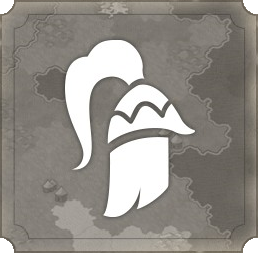
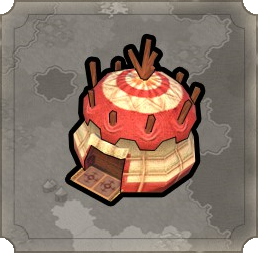

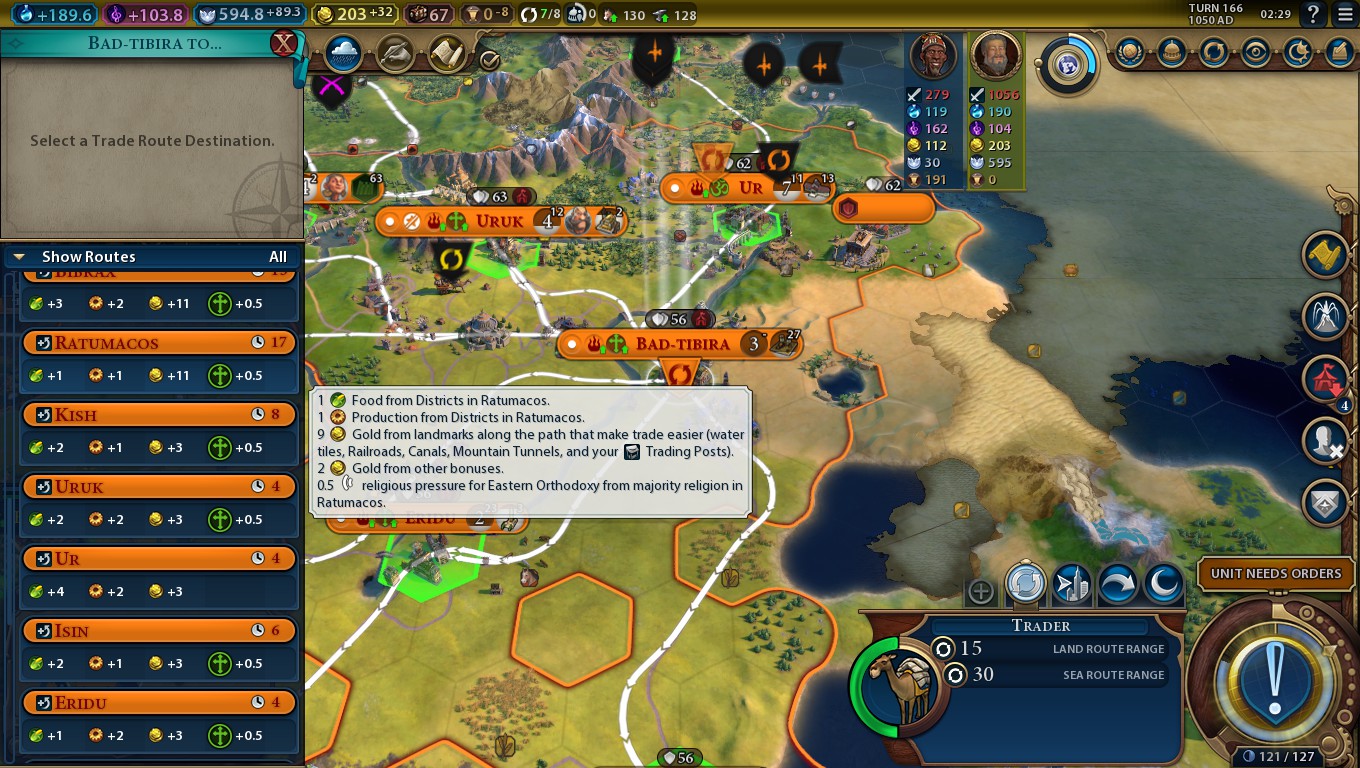
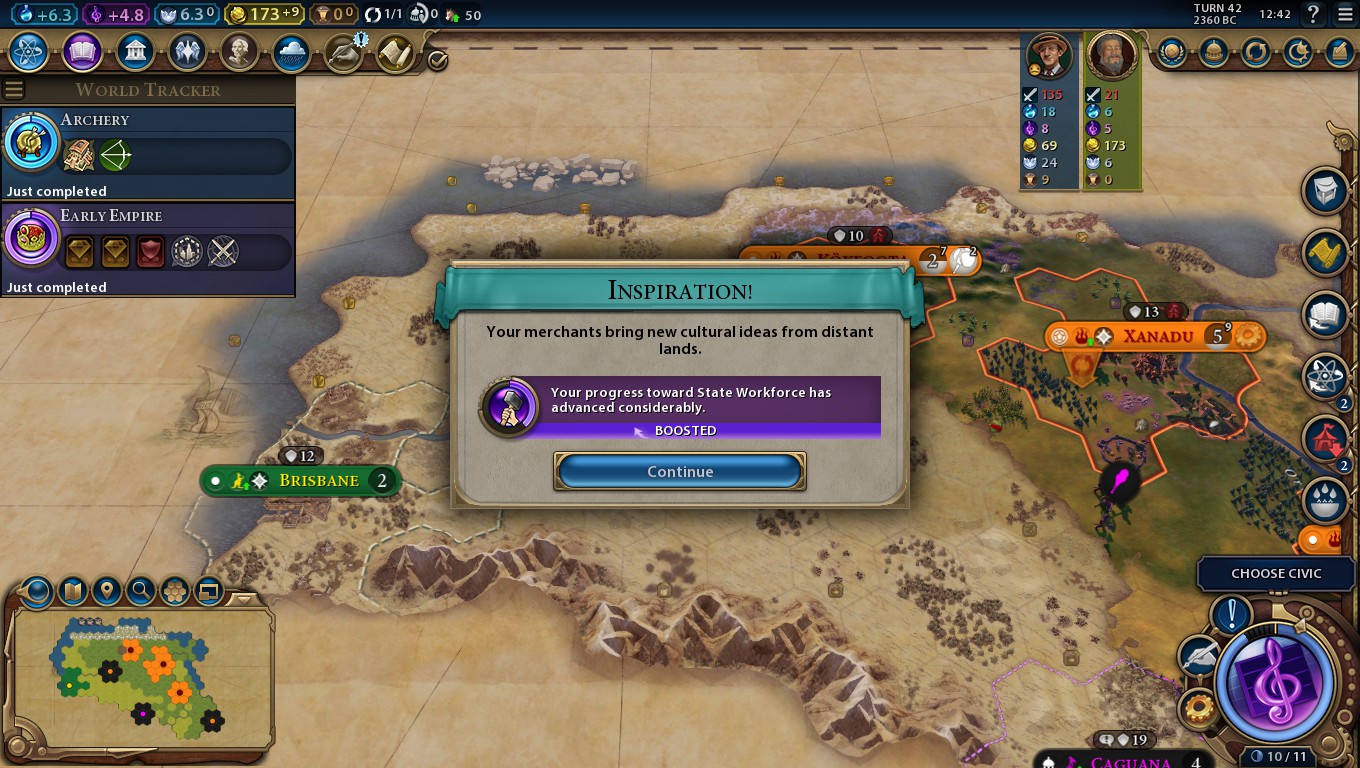
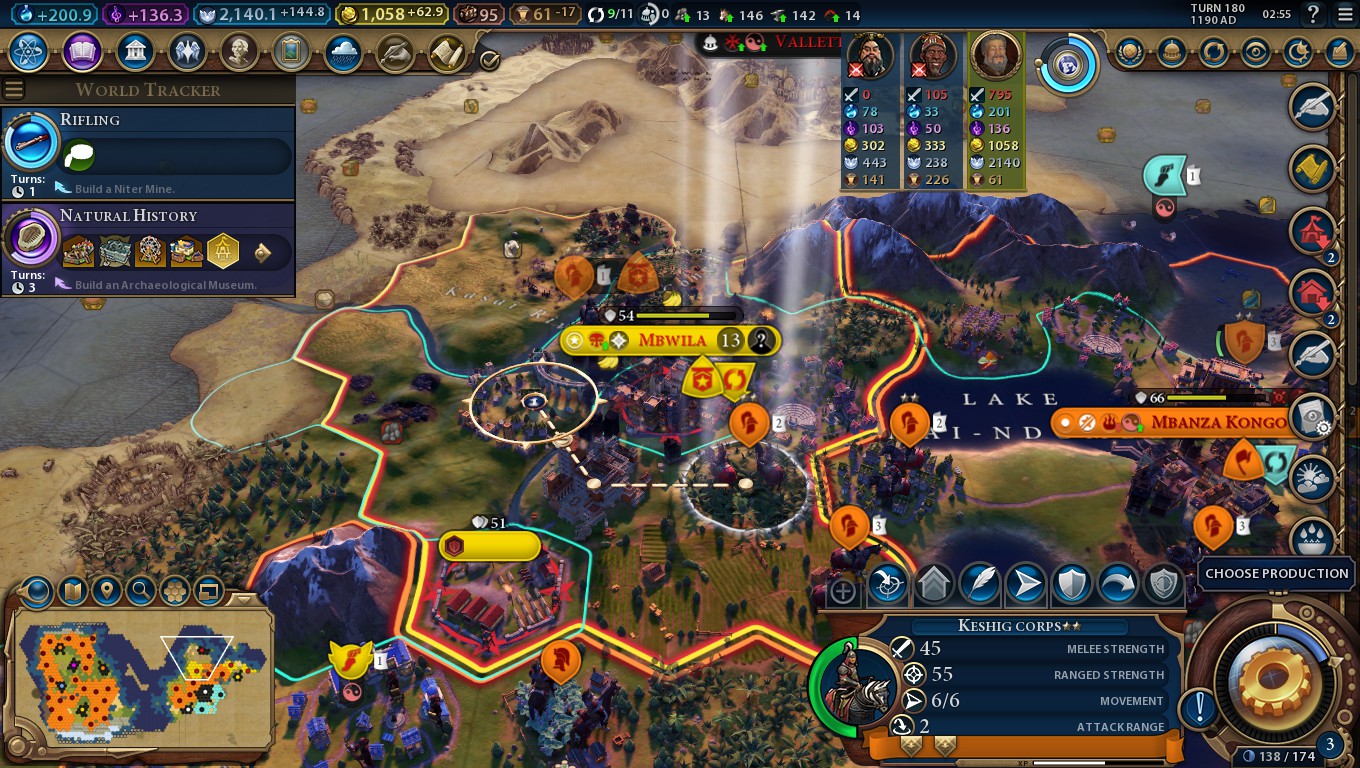

Leave a Reply